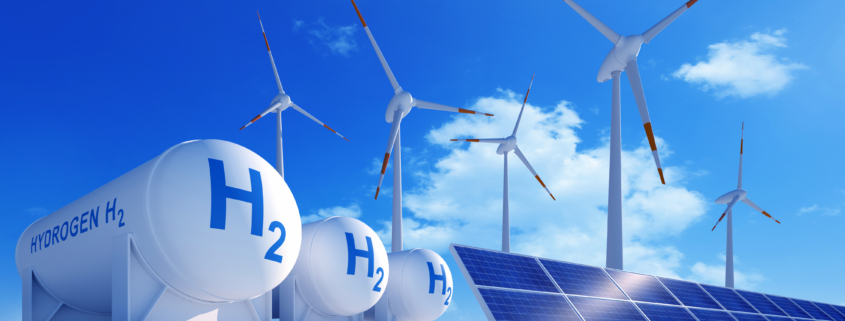Will Digitalization aid the world’s quest to net-zero emissions?
The increasing global awareness of climate change and the irreversible damages caused has led the world to a code red. Wildfires, floods, heatwaves, earthquakes… all over the globe have been part of the awakening call, demanding humanity to change its consumption behaviours. The younger generation is the 1st one living the repercussions of a whole system of production and consumption that was built with many things in mind but sustainability. Only a drastic reduction in greenhouse gas emissions can stabilize global temperature. However, achieving this will require a severe shift to renewable energy solutions.
During the Paris agreement also known under the name of Paris Climate Accord, over 191 countries joined with the commitment to reduce their CO2 footprint, to reach the common goal of net-zero emissions by 2030. After this event, the number of projects to generate sustainable energy sources increased significantly. One alternative that would allow the world to transition to renewable energy has gained major traction and widespread awareness mainly due to its potential to serve energy, in large and scalable quantities to hard to abate sectors; industry, transportation, aviation, and maritime.
“Green-Hydrogen” is also known as the “green oil of the 21st century”
The use of Hydrogen is already widespread, however over 95% of it, is produced from natural gas and coal, making the production process unsustainable. Green-Hydrogen on the contrary is a sustainable, carbon-neutral fuel produced through electrolysis. Electrolysis is fundamentally the process in which electricity is used to split water (H2O) into Hydrogen and Oxygen. This production process, to generate an alternative energy source, has a high potential to play a key role in the shift towards net-zero emissions. Why isn’t green hydrogen’s use widespread yet? The cost of production is in comparison to regular hydrogen, two to three times higher, making the transition towards massive adoption not viable from an economic standpoint.

Figure 1: Electrolysis Source: DW
Some other aspects need to be in place to fully enable the adoption of green hydrogen such as; policy-making, regulatory frameworks, incentives for its adoption, risk capital, investment in the necessary infrastructure for its production and transportation as well as reliable commitments across both public and private sectors. The challenge to decrease production costs of green hydrogen has been pointed out as the main roadblock by major project leaders in this ecosystem: Denmark, Germany, Chile, IRENA, World Economic Forum, the COP26 High-Level Champions, the Global Environment Facility, Bloomberg Philanthropies, and UN-Energy (Ministry of Foreign Affairs of Denmark, 2021).
How to reduce production costs of green hydrogen?
Scaling and improving electrolyzers have the potential to decrease costs by 40% short-term and 80% long-term reaching cost-pairing with regular hydrogen by 2025.
“Digitalization and sustainability coexisting will boost the transition to Green Hydrogen”
Digital technology is one of the main pillars to accelerating the shift to green hydrogen (Ouziel and Avelar, 2021). An increase in technology maturity is working as an enabler to solve many of the still existing burdens for a successful transition and support the production of green hydrogen.
Let’s explore the key players within the digital realm:
1. Solid Oxide Electrolysis Cell Technology (SOEC) has come into the field as the main actor to potentially solve the cost reduction problem achieving a set of economics that create commercial viability. SOEC conversion efficiency has not yet been matched by any other technological advancement.
Haldor Topsoe is building the world’s first and largest SOEC plant in Europe intending to bring innovative electrolysis technology into the global market by 2023 (Ministry of Foreign Affairs of Denmark, 2021).
The plant will produce green hydrogen with less energy in comparison to its production through any alternative method, the increased efficiency allows the generation of enough energy in form of fertilizers, fuel, and chemicals to supply the hard to abate sector. “We have the technology to make this vision a reality” Haldor Topsoe’s statement on their official website. The production methods used by this technology are scalable and based on abundant raw materials. SOEC has moved from the R&D stages, into scaling for commercialization. The continuous process improvements are on the way to enabling larger and more efficient plants in the near future.
Demand for efficient energy production technologies is predicted to increase, turning it into a trillion-dollar market by 2050 attracting new companies to position themselves through innovative business models capable of meeting the market demand. This scaling will help bring down production costs and, make the adoption of green hydrogen viable.
Available energy from natural sources such as wind and solar exceed multiple times the global energy consumption, the challenge we face as a highly interconnected world is the integration of infrastructure powerful enough to meet to overall energy demand. Therefore, to build a system that can be based on green hydrogen, we heavily rely on technology.
2. Artificial Intelligence of Things (AIoT) has come to play a key role to measure the key performance indicators (KPI) within such integrations, capable of controlling and monitoring the overall energy consumption within a system, the plant performance, the production capabilities as well as the effectiveness and efficiency of its processes. AIoT can detect anomalies by providing real-time reporting through cloud-based remote monitoring.
Furthermore, this technology enables the collection, structuring, and visualizing of data, into reports used for effective measuring, monitoring, and process enhancement.
There is a large initial investment required to set up a scalable system, which also comes in hand with maintenance. In the past, this investment along with the steep learning curve and the need to fill all the specialized job positions would have scared many companies off, slowing down the transition period and mass adoption.
3. Digital twins however are allowing companies and investors to test before committing any capital. To operate within a young and immature ecosystem where many variables must be considered, having digital twins is ideal, allowing the modelling and design of different scenarios to optimize a selected model to maximize ROI and decrease potential risks. Estimations indicate that digital twins are reducing risk by 30 and up to 50%.
4. Advanced analytics are used to manage the vast amounts of newly generated data and translate it into actionable insights. From actively measuring carbon footprint through the collection of data from different sources, to determine the key origins of emissions, all the way to extracting and learning from various data sources to come up with recommendations on how to prevent energy losses within the value chain process, optimizing electrolyzers, increase revenues… allowing companies, as well as investors, take strategic decisions.
“Digitalization brings powerful tools; however, they do not come without risks!”
Serval risks come in hand with utilizing the above-mentioned digital tools. Early adoption demands larger investments in research, the technology perse, specialized experts in this new field, as well as periods of trial & error until the maturity needed to scale is reached. The risk of a breakdown of the electrolysis technology must be taken into account. An interruption in the production process would mean significant and costly losses. Any smaller defect present in the technology as the key process driver will lead to production delays.
Improper maintenance would of the equipment causes corrosion that can end in an oxygen-hydrogen-gas explosion. And, how do we ensure the safety and privacy of all the collected data? Collaboration between all stakeholders, companies, governments, the scientific community, and scholars will be key to realizing profits and achieving this transition.
“Technology by its self, will not be an agent of change.”
Digital solutions will be vital for the transition to green hydrogen, yet, to effectively produce and spread adaption, joined common goals and collaborative action will be key! With the aim of building a world nurtured by renewable energies, I invite the reader to, by interest, continue exploring possibilities and maintaining the hope but also effort to form part of this active global transition.
References
- Ouziel, S. and Avelar, L., 2021. 4 Technologies Driving The Green Hydrogen Revolution. World Economic Forum. Available at: weforum.org/agenda/2021/06/4-technologies-accelerating-green-hydrogen- revolution.
- Ministry of Foreign Affairs of Denmark, 2021. Green Hydrogen Compact Catalogue. Ministry of Foreign Affairs of Denmark, p.91.
United Nations, 2021. The Paris Agreement | United Nations. United Nations. Available at: un.org/en/climatechange/paris-agreement. - Hauch, A., Küngas, R., & Blennow, P. (2021). Recent advances in solid oxide cell technology for electrolysis. Available at: science.org/doi/10.1126/science.aba6118 (HQ), H. (2021). Green Hydrogen | Efficient green hydrogen electrolysis. Retrieved 8 December 2021
- Yixiang, S., Yu, L., Ningsheng, C., Jiqin Q., Shaorong W., Wenying L., Hongjian W. Experimental characterization and modeling of the electrochemical reduction of CO2 in solid oxide electrolysis cells, Electrochimica Acta ,Volume 88,2013,Pages 644-653, ISSN 0013-4686, Available at:
https://doi.org/10.1016/j.electacta.2012.10.107. - Rethinking hard-to-abate sectors | Lombard Odier. (2021). Retrieved 11 Available at: lombardodier.com/contents/corporate-news/responsible- capital/2021/september/challenge-or-opportunity-rethink.html
- CLIC™ Economy | Sustainable Investment | Lombard Odier. (2021). Available at: lombardodier.com/clic
- (HQ), H. (2021). Hydrogen | H | H2 | Process | Catalyst | Technology. Available at: topsoe.com/processes/hydrogen
Fortescue Future Industries. (2021). Available at: ffi.com.au - Rigas, H. (2021). How to harness the top 10 emerging tech of 2020 for good. Available at: weforum.org/agenda/2020/11/how-to-harness-the-top-10- emerging-tech-of-2020-for-good
- Wójcik, A. (2021). Article in Science: Solid oxide electrolysis cell technology to unlock the full potential of renewable power. Available at: blog.topsoe.com/article-in-science-solid-oxide-electrolysis-cell-technology-to- unlock-the-full-potential-of-renewable-power
- Avelar, L. (2021). How to bridge the gap between climate rhetoric and action. Available at: weforum.org/agenda/2021/07/fight-climate-change-with- technology/
About the Master Digital Administration

This article was written as part of the Master’s programme in Digital Business Administration at BFH Wirtschaft. The degree programme teaches the relevant skills to help shape the digital future of business and society. Thanks to current live cases from companies in the digital transformation, the study programme is strongly practice-oriented and provides experience in dealing with current and new digital technologies.
 Create PDF
Create PDF





 Contributions as RSS
Contributions as RSS
Leave a Reply
Want to join the discussion?Feel free to contribute!